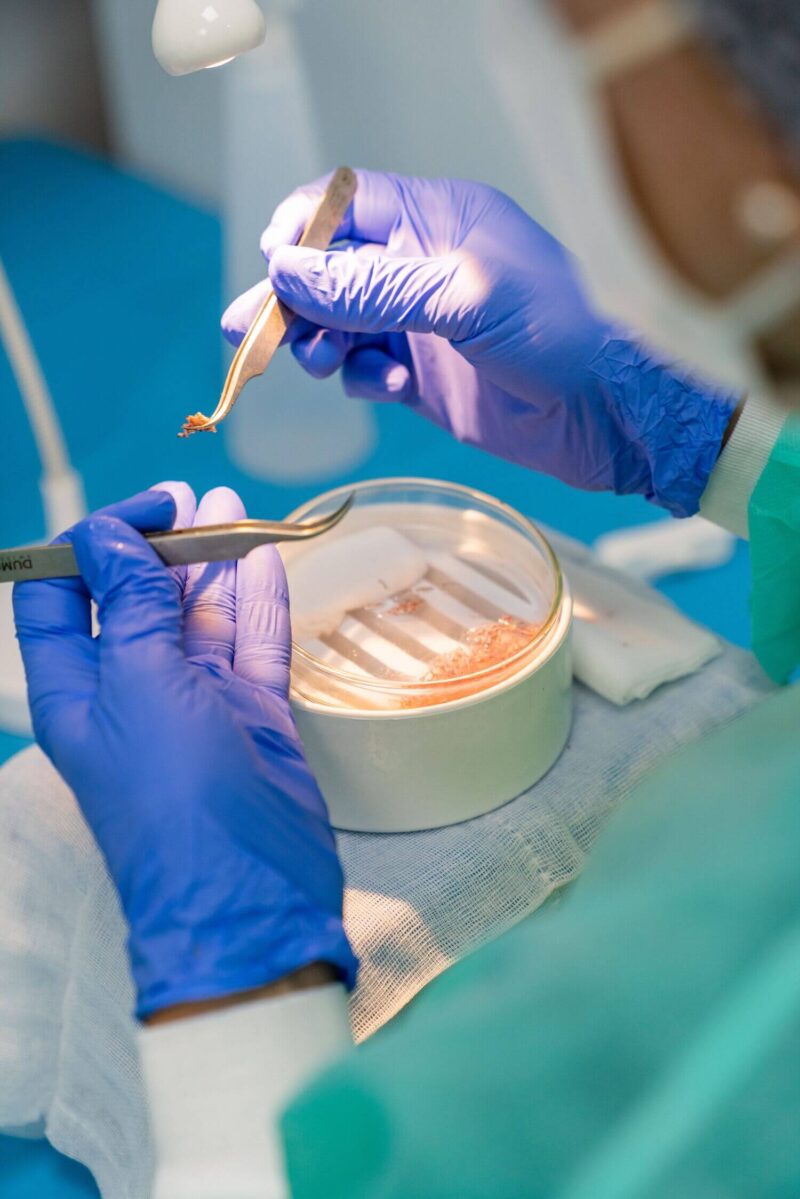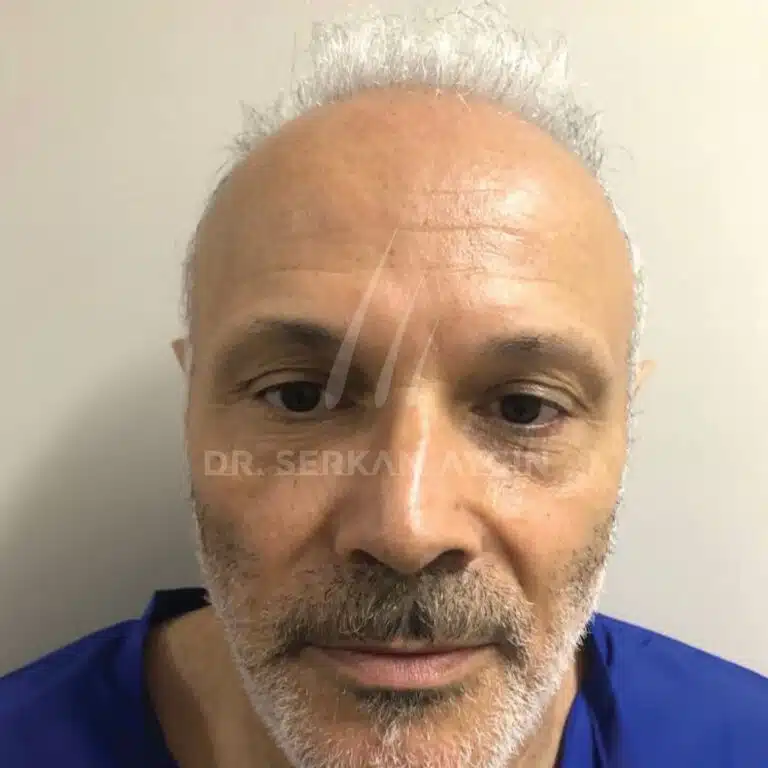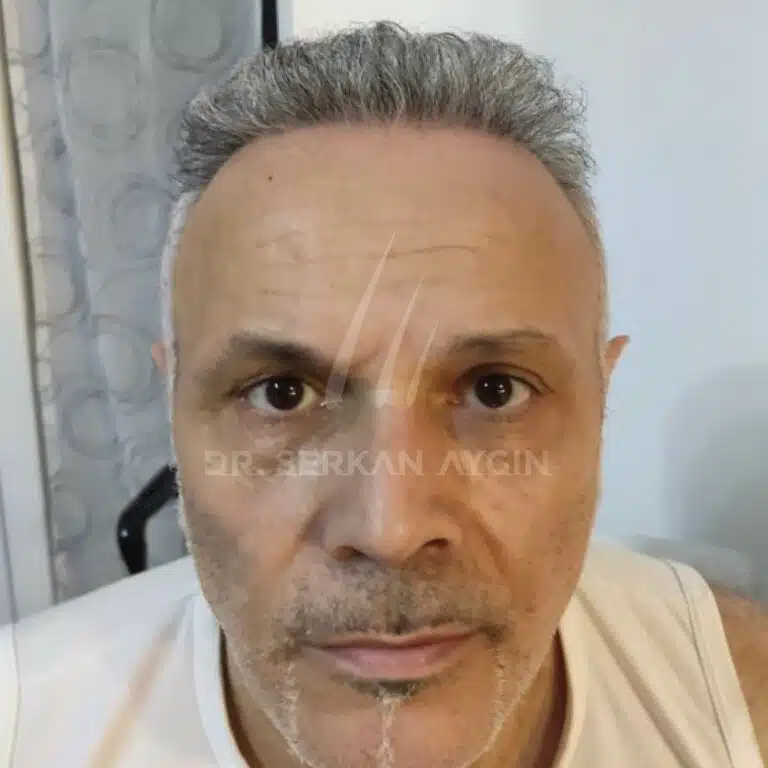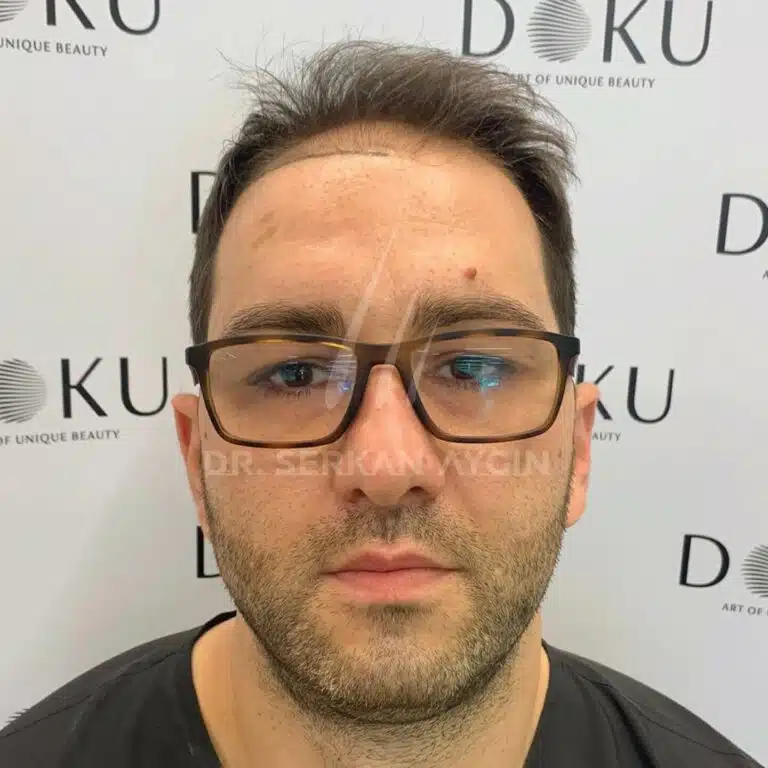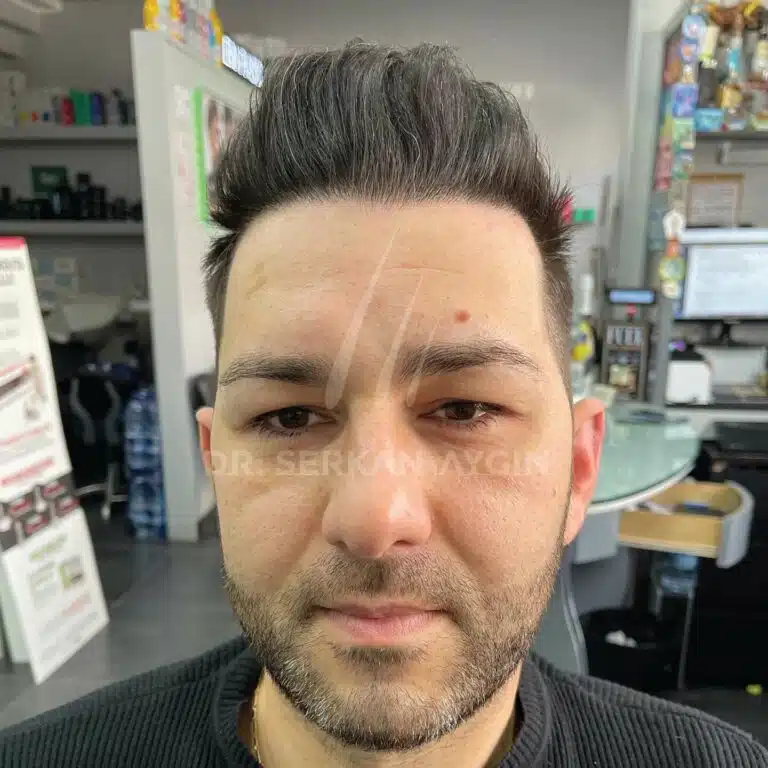Follicular unit extraction (FUE) is a hair transplant surgery method utilizing a rotating punch instrument. The sharp edges of the tool go under the skin, turn manually or with motor assistance, and extract each hair follicle one by one.
FUE is the usually preferred technique worldwide for hair transplant surgeries. To have gorgeous results, in 2022 75.4% of men and 57% of women chose FUE according to the ISHRS report.
Here are some key points we mentioned in the article:
- FUE HAIR TRANSPLANT IS A POPULAR PROCEDURE WITH OVER 95% SUCCESS RATE.
- THE PROCEDURE IS ABOUT EXTRACTING HAIR FOLLICLES AND THEN INSERTING BALDING AREAS.
- THERE ARE FOUR SUBTYPES OF IT; MICRO FUE, SAPPHIRE FUE, SOFT FUE, AND ROBOTIC FUE.
- THE HARVESTING TECHNIQUE OF FUE IS WHAT MAKES IT UNIQUE, THE REST OF THE PROCEDURE IS SIMILAR TO CLASSIC HAIR TRANSPLANT PROCEDURES.
- SOME OF THE DRAWBACKS ARE PINPOINT SCARRING AND LONGER SURGERY TIME.
What Is A FUE Hair Transplant?
Follicular unit extraction (FUE) is a hair transplantation method with a less invasive follicle harvesting approach. To transplant the hair, follicular units are extracted from the donor site and planted over your balding areas one by one to make natural hair grow there.
So, we can assure you that it is a popular one.
Key Factors Distinguishing FUE Method
- HAIRS ARE COLLECTED INDIVIDUALLY
- HIGHER CHANCES FOR A DENSER LOOK
- YOU DO NOT LOSE A STRIP OF HAIRLINE
- SINGLE HAIR TRANSPLANT WITH UP TO 5,000 HAIR GRAFTS
- ONE OF THE NEWEST APPROACHES IN HAIR TRANSPLANT
- THE ONLY USEFUL TECHNIQUE FOR BODY HAIR TRANSPLANT
- POSSIBLE TO GRAFT THOUSANDS OF FOLLICLES IN A DAY
What Is The Success Rate Of The FUE Technique?
FUE hair transplant surgeries are considered successful if more than 60-70% of the planted hair survives. Whether performed with FUE or another method, hair transplant surgeries have a success rate of more than 95%, and it is even higher with an experienced doctor.
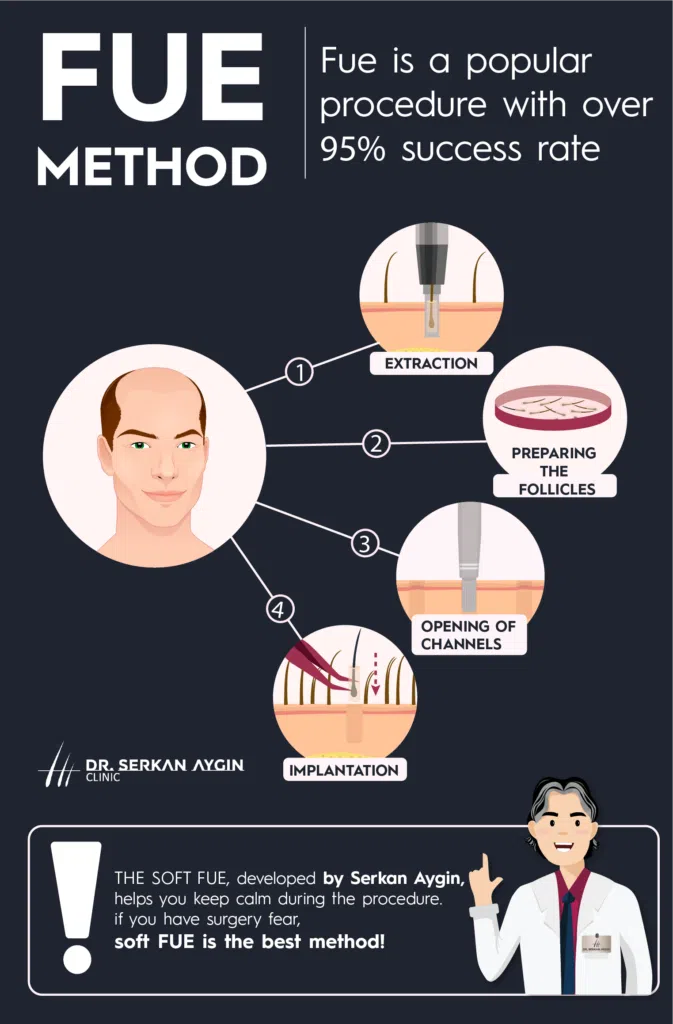
Is FUE Hair Transplant Permanent?
Yes, FUE hair transplant procedures are permanent. It gives long-lasting results and changes your appearance for a lifetime if you take good care of your newly transplanted hair. The planted hair has a high success rate.
There is even a study that showed 90% of 820 patients were satisfied with a year-long result, but how is that? Thanks to donor dominance theory. In an FUE procedure, the dominant donor hairs are transplanted to the bald area and stay there for a lifetime.
How Do FUE Hair Transplant Results Look?
You will have hair on once balding areas. What you will see in the mirror will be nothing but what you desire. You can cut the planted hair, shape it with a comb, and dye it.
All you need to do is to wait for a year till the hair follicles find their place to see results like these:

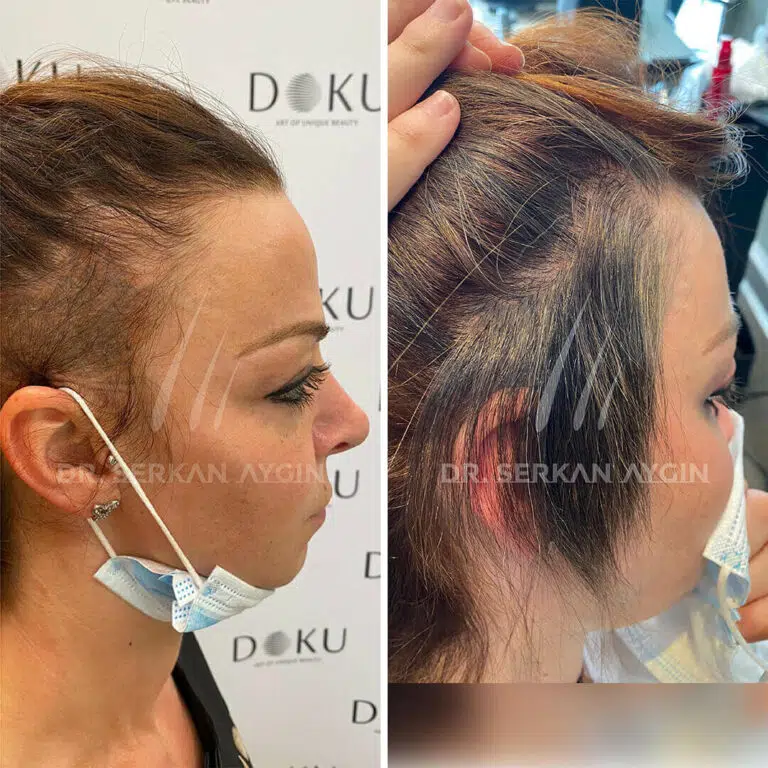
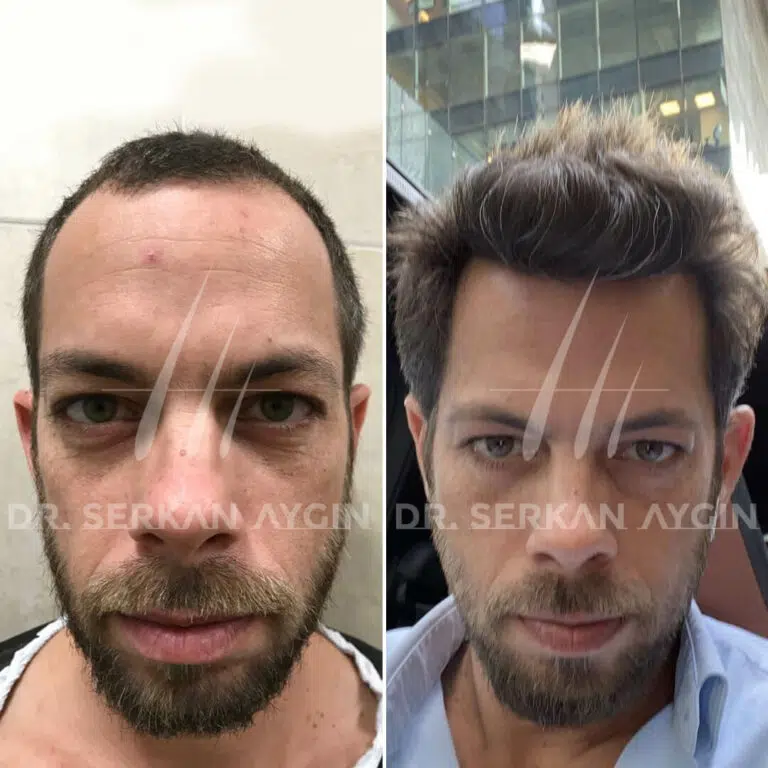
FUE Hair Transplant Procedure Steps
After shaving and application of anesthesia, to perform an fue procedure, three main steps are followed:
1️⃣ Collecting the hair tissues:
As a starter, the doctor or the operation crew harvests the hair with a micromotor device. Around 0.9 mm depth, the device gets into the scalp, twirls in, and extracts the hairs out, aka the hair follicles.
2️⃣ Preparing the follicles:
The collected follicles are then preserved in a hypothermosol solution to keep the grafts alive and set ready for the operation.
3️⃣ Covering the balding areas:
To cover the balding areas the follicles are inserted in the scalp. First small hosting channels are made, and then the follicles are implanted one by one.
The whole procedure can take 4-8 hours. When you need a huge surgery requiring 4000-5000 grafts, then it can take longer up to 10 hours.
Below, you can see Dr. Serkan Aygin Clinic’s FUE hair transplant in Turkey to have a clear understanding of the procedure.
What Are The Subtypes of FUE Hair Transplant?
FUE has five different types, and the difference between them is all about the insertion and extraction, which are:
- REGULAR FUE: THE SEMI-AUTOMATED METHOD
- MICRO FUE: SMALLER BLADE OF MICROMOTOR FOR HARVESTING
- SAPPHIRE FUE: PERFORMED WITH A SAPPHIRE SCALPEL
- SOFT FUE: MAKES YOUR SURGERY MORE COMFORTABLE
- ROBOTIC FUE: OPERATED WITH ROBOTIC ASSISTANCE
Regular FUE
During an FUE, doctors use the device -micro motor- for harvesting. The device has turning sharp circular edges at the tip of it to extract the follicles. This is a convenient way of harvesting follicles and comes with lots of benefits:
- Reduced surgery time: the follicles are easily and delicately extracted with the automatic rotations of the device
- Reduced trauma: gives less tissue damage and keeps your other follicles intact while harvesting
- Increased success and satisfaction rates: takes out every follicle gently with precision, keeping them in the perfect shape they should be
- Natural-looking results: the surgery results look natural, as if it’s your own hair, thanks to the precise follicle harvest
- Combined surgery chance: this method can easily be combined with other hair transplant methods for a greater surgery
Micro FUE
For much more density the micro motor device is even smaller in micro fue. The diameter of blades used in micro fue is about 0.6-0.8mm. Thanks to these tiny sharp blades, it is possible to acquire a lot more micrografts at a time with lots of other benefits:
- Micro blades: smaller surgery scars, less bleeding during the surgery, and lower hair transection rates are possible with micro fue
- Higher precision: compared to regular fue, you can expect much more precision with microblades
- Increased harvesting: up to 5000 grafts can be harvested with the micro fue procedure
- Only possible with experience: the harvested grafts will bear less skin tissue calling for much more expertise to harvest and implant
Sapphire FUE
In sapphire FUE, the small hosts for hair follicles are made with a sapphire blade. Sapphire is a precious gemstone and is harder than steel. It can be used in fue hair transplant surgeries as a blade material.
Sapphire blade has many benefits compared to the regular steel, metal blade:
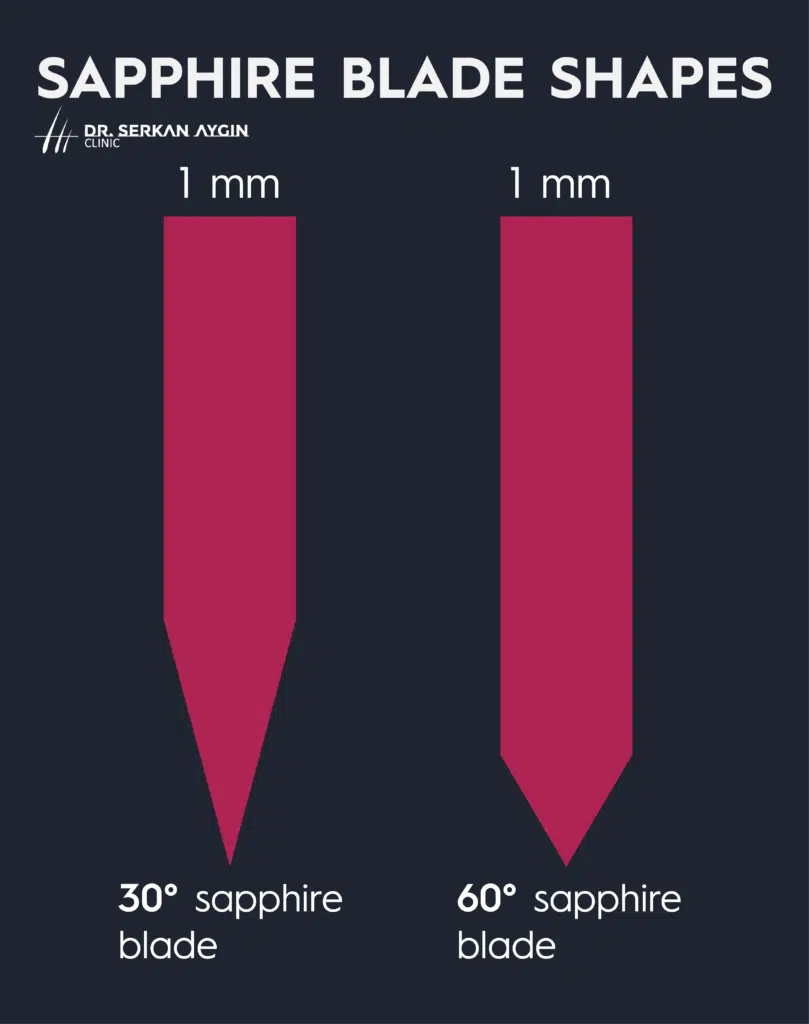
- Minimal scarring: the head of the sapphire blade has a crystal-shaped head, that can go under the skin without disturbing the tissue
- Faster healing: thanks to the crystal-shaped head, you can have less and less scarring, increasing the recovery speed
- Better angle control: the shape of the blade allows for better angle and direction control than regular method
- Antibacterial properties: sapphire has antibacterial properties reducing the risk of infection
- Higher chances of graft survival: the implanted grafts will have much more connection to the scalp, thanks to the sapphire blade channel
- No-allergies: anyone with a metal allergy can benefit from the sapphire blade, and have hair transplantation with almost no risks
- Perfect results with any hair type: whether have curly, straight or long hair, the sapphire blade is suitable for all
Soft FUE
With soft FUE, you will have sedation even before the anesthesia. The soft FUE method, developed by Dr. Serkan Aygin himself, helps you keep calm during the procedure and gives you relief from your surgery fears.
- Smooth operation time: the operation will take place in a much more comfortable place
- The best for needle anxiety: if you have surgery fear, soft fue is the best method
- Have homelike comfort: you will have the operation in a really relaxed mood as if you are at your home
- Increased precision: the more stable the patient thanks to the sedation, it is easier to place the grafts
- Enhanced pain management: the surgery itself is not painful at all but you will not even feel the needle with soft FUE
Robotic FUE
Robotic FUE is performed by using sensitive cameras and precisely motorized needle injections. First, the donor area is monitored by laser cameras in a robotic method. Then, depending on the used device, follicles are extracted manually or with robotic assistance. Finally, the follicles are transplanted manually.
- Precision in each follicle: robotic monitoring of the donor area, decreases the slight chance of overharvesting
- A convenient method for the team: there is less need for human interaction thanks to the sensitive cameras and motors
- No place for a mistake: although the device works automatically, it works under the doctor’s assistance at any second
Factors To Consider When Choosing A Team For FUE Procedure
While you usually choose and meet with the doctor for your hair transplant procedure, the operation team plays an important role in the surgery’s success too. Make sure to check:
- IF THE OPERATION TEAM HELPS YOU UNDERSTAND THE PROCEDURE
- IF THE DOCTOR HAS BEEN WORKING WITH THE TEAM FOR A LONG TIME
- IF THEY PROVIDE YOU ASSISTANCE ANY TIME YOU NEED THEM
- IF ALL THE TEAM MEMBERS HAVE RELATED DEGREES AND SKILLS
Advantages Of The FUE Method
- PARTIAL SHAVING IS POSSIBLE
- MINIMALLY INVASIVE
- PAIN-FREE
- DOES NOT LEAVE A LINEAR SCAR
- NO NEED FOR STITCHES
- USES MICRO MOTOR DEVICE
- POCKET-FRIENDLY
The Drawbacks Of A Perfect FUE Operation
- PINPOINT SCARRING
- PATCHY HAIR THINNING
- OVERHARVESTING
- HIDDEN GRAFT TISSUES
- FORMING OF CYSTS
The Affordability Of FUE Hair Transplant As A Benefit
Besides all the other benefits, FUE hair transplant cost is a pocket-friendly one. The procedure is performed effectively with the micromotor device. Thanks to this convenience, what you pay is lower and much more affordable.
The average cost of the FUE hair transplant is between $2,000 and $20,000. However, if you opt for sapphire FUE, the price range goes slightly up to $2,300-$35,000. This is because sapphire blades are custom-made, contributing to the higher cost of this advanced technique.
Who Can Benefit From A FUE Hair Transplant?
You can benefit from fue hair transplants if you relate to any of the following criteria:
- IF YOU ARE UNSATISFIED WITH YOUR HAIR DENSITY
- IF YOU ARE EXPERIENCING GENETIC OR AGE-RELATED HAIR LOSS
- IF YOU ARE SEEKING A MINIMALLY INVASIVE OPTION
- IF YOU HAVE ENOUGH DONOR HAIR ON THE BACK OF YOUR SCALP
- IF YOUR SCALP IS HEALTHY IN TERMS OF SKIN DISEASES
With FUE, Reduced Scarring In Hair Transplant
What you consider as scarring is the result of the donor site harvesting procedure. Any hair transplant surgery whether fue or fut would leave scarring behind.
Thankfully, FUE is known to leave the least scarring. This is thanks to the individual and diffused harvesting of the follicles. These tiny FUE scars can only be seen when your hair is shorter than ¼ inches.
Importance Of Reduced Scarring In A FUE Hair Transplant
The fue method is developed to leave less scarring on your scalp. Thanks to the fue method’s reduced scarring you can:
- RECOVER FASTER
- ENJOY SHORT HAIR
- HAVE HIGHER SATISFACTION
- KEEP MOST OF YOUR DONOR HAIR
- CAMOUFLAGE THE SURGERY BETTER
Differences in Scars Between FUE and FUT
Both FUE and FUT procedures harvest the back of your head and leave scarring. Fue leaves tiny and diffused scars, while fut leaves a strip of line.
- Fue scarring looks better in time. With your short hair coverage, you can completely cover the scar.
Fut scarring does not improve. To cover your fut linear scarring, you might need a little bit longer hair, compared to fue.
Is FUE For You If You Don’t Want Scars?
Yes, you should prefer fue if you do not want scars. Even though the method is not scar-free, it is your best option to have the least scarring.
You will not even try to cover the scarring. When you complete your recovery, as your hair gets longer, it will naturally cover the tiny scarring dots of the follicle extraction process.
Post-Op After A FUE Hair Transplant
Once you finished your fue hair transplant surgery, a bandage will cover your head and usually, it will be removed that day. The back of your head and the planted area may look unnatural, but this is only for 7 – 12 days.
Generally, the full recovery from an fue hair transplant procedure takes a year, but it varies since not all people heal the same way.
Is The Post-Op Different With FUE?
Yes, it is different and the only difference between fue compared to fut is the recovery process of the donor area. Fue does not require stitching of the donor area. Once the surgery is complete, the tiny dots of scars heal by themselves nicely.
Unlike the other methods, you don’t need to wear a bandage for 2-3 days on the back of your head after a fue procedure.
Tips For Ensuring The Perfect Results Post FUE
Although having multiple hair transplants is possible when you are not satisfied or you had a complication, you should be attentive to your surgery areas. Here, we have some tips on how to keep your planted hair follicles intact and to have a healthy FUE procedure.
- SLEEP ON YOUR SIDE
- DO NOT RUB THE RECIPIENT AREA
- ITCHY FEELING IS BEST CURED BY WASHING
- DO NOT SQUIRT A PRESSURED STREAM OF WATER ON THE RECIPIENT AREA
- YOU CAN USE RECOMMENDED PAINKILLERS FOR MILD PAIN
- LET YOUR DOCTOR KNOW IF THERE ARE ANY SIGNS OF COMPLICATION
- DO NOT MISS YOUR POST-OPERATIVE VISITS IF YOUR DOCTOR ASKS YOU TO
Let’s look at some hair transplant before and after pictures together!
REFERENCES
(1) 2022 ishrs practice census results
(2) Global hair transplant market (skyquestt.com)
(3) Sethi p, bansal a. Direct hair transplantation: a modified follicular unit extraction technique. J cutan aesthet surg. 2013;6(2):100-105. Doi:10.4103/0974-2077.112672
(4) Bansod, shashank et al. “History of follicular unit excision.” indian journal of dermatology, venereology and leprology vol. 87,2 (2021): 315-318. Doi:10.25259/ijdvl_1071_20
(5) Kerure as, patwardhan n. Complications in hair transplantation. J cutan aesthet surg. 2018;11(4):182-189. Doi:10.4103/jcas.jcas_125_18
(6) Alhamzawi nk. Keloid scars arising after follicular unit extraction hair transplantation. J cutan aesthet surg. 2020;13(3):237-239. Doi:10.4103/jcas.jcas_181_19
(7) Ahmad m, ismail m. Effect of different shapes of recipient site creation micro-blades at varying angles and wound injury. J cosmet dermatol. 2021;20(11):3610-3615. Doi:10.1111/jocd.14006


